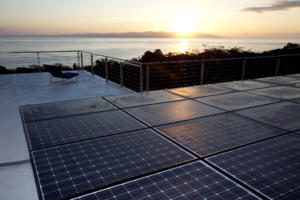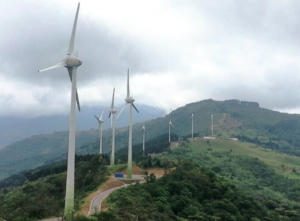Kyriakos Anastasiadis, TheCostaRicaNews.com
Costa Rica is a pioneer in renewable energy sources. The country achieved to satisfy more than 90% of its energy demands by exploiting clean, natural energy sources, especially water. Costa Rica aims to become the first carbon-free economy on the planet by the next decade and many people think that other countries should also commit to this impressive and noble goal. The planet suffers from heavy pollution and if things stay the same, Earth will be a dangerous place to live in the near future. According to the Shell Report, energy demands will at least double or even triple by the year 2050, resulting in a dramatic increase in fossil fuel consumption and therefore more greenhouse gases. So Costa Rica’s energy policy could be a reliable and cost effective alternative that will lead to a cleaner planet. But is that the case? There are voices that doubt this claim and although still not heard, they should not be ignored.
Costa Rica’s Energy Profile
Costa Rica satisfies its energy demands almost entirely from renewable sources. Hydroelectric power holds a share in electricity production above 80%, including storage. Next comes geothermal power with a share of 12% and the rest is covered by other sources like oil powered plants, coal, solar and wind farms. The country imported almost 18 million barrels of crude oil in 2010. Due to the increased oil prices, the cost reached 2 billion US dollars. 95% of the imported oil is used for transportation and the remainder to power energy plants. An impressive characteristic is that Costa Rica is among the few countries with zero oil and gas production, despite the fact that there are indications of offshore deposits. They are not vast, but an investment in their exploitation has a guaranteed break-even point and since Costa Rica’s fossil fuel needs are quite small, they could satisfy a considerable percentage.
Criticisms and risks of Costa Rica’s energy policy
Costa Rica made the innovative strategic choice to invest in renewable energy sources. The nation must be praised, since besides the escalating oil prices, an investment in renewable sources is still costlier. As a result, consumers pay a premium for electricity and this is not going to change in the near future. But it is one thing to design a clean energy policy and another to implement it successfully. An ineffective execution of such a policy could easily create problems that will eliminate all of its potential benefits.
Costa Rica invested heavily in hydroelectric power, which holds the lion’s share in satisfying its energy demands. As a result, the country depends totally on nature which contradicts a major parameter of a clean energy investment – to reduce a country’s energy dependency. Perhaps, Costa Rica does not depend on oil production countries, but it depends on nature, which is more dangerous, since nature is uncontrollable. Even a small, local climate change could easily diminish Cost Rica’s energy production capacity. According to the accepted scenarios, global warning will cause a dramatic climate shift in the next few decades, reducing the available time for Costa Rica to diversify its strategy. A global initiative to a sustainable energy system cannot be established without the United States and since they are not willing to commit, there is not going to be a reduction in carbon emissions that could reverse the situation. Therefore, if global climate change reduces rainfalls in Costa Rica, the country will face a situation that will cripple its economy.
Another criticism regarding the country’s reliance on hydroelectric power is its effect on the local environment and inhabitants. Dams affect flooding patterns and cause the relocation of the local population. When humans change natural processes, the results are catastrophic and usually irreversible. The country is blessed with amazing nature and it would be tragic to destroy it. Reliance on hydroelectric power contradicts other major parameters of a clean energy policy – to protect the environment and improve the quality of life.
Diversity is the key to an effective energy policy

Nowadays, technological innovations offer the possibility for cost effective investments in renewable energy sources. The most attractive options are solar and wind power. Costa Rica is blessed with daily sunshine and winds strong enough to power wind turbines, and an investment in these sources can offer immediate results. Unlike dams, solar and wind farms are easily constructed, can be online fast, and can be placed anywhere since they are not limited by the necessity of a local power source or a minimum production level. There are farms in the world with just a handful of turbines or solar panels. Therefore, Costa Rica can form a strategic plan adjusted to the energy demands of each territory, reducing delivery costs and increasing efficiency.

The usual criticisms on solar and wind power are the initial cost and their impact on the local environment. As for the cost, it does not affect Costa Rica, because they are expensive compared to fossil fuels, as are dams – Costa Ricans are already paying a premium for electricity. A diverse energy system will allow Costa Rica to offer its citizens cheaper power by implementing the Merit Order system. In short, this system allows the energy plants and farms with the lower marginal cost to go online first, and the more expensive plants only go online in peak hours or in case of emergency. Therefore, most of the time, energy is produced by the least expensive sources, reducing electricity prices. As for the environment, solar and wind farms have only an aesthetic impact, and unlike dams, they can be removed at any time. Any country can find locations to establish these farms, but Costa Rica has the advantageous option to construct offshore wind farms which are more expensive initially, but more efficient due to the stronger winds.
A main advantage of solar and wind power is that they offer the government the option to allow private citizens and businesses to becoming part of the infrastructure and contribute to the energy production cost. Subsidization is necessary, but the cost is considerably lower in relation to the cost of building new dams, and private energy production will increase the effectiveness of the Merit Order system, since there will be available power with zero cost for the state.

Transportation is the only obstacle for Costa Rica to establish a carbon free economy. Although it is impossible to zero oil imports, there are ways to minimize them. The first and easiest step is public transportation and taxis. Many developed countries are using electric powered buses and have started to introduce hybrid cars in to their taxi fleets. A second step is to retire the entire state car fleet and replace it with hybrids. Of course these cars are expensive, but Costa Rica is paying almost 2 billion US dollars per year for oil imports. Hybrids will decrease this amount and the saved money could be used for their subsidization, so they can be affordable even for the average citizen. And the high price is only an initial cost – the reduced oil imports will offer yearly savings.
Another option for the country is to establish cooperation with a manufacturer. Japanese companies are pioneers in hybrid and electric cars and Europeans are catching up quickly. The government can offer them land and tax benefits for establishing a production line. They will have the obligation to produce the necessary hybrids and electric cars to satisfy the country’s needs, and the government will not tax the locally produced cars in order to be affordable without subsidization. This would introduce thousands of new jobs, technology transfer, and the possibility for local businesses to grow next to the car factory. Car factories require hundreds of other businesses to support them, and therefore they will offer major opportunities and even more jobs.
Successful examples of clean energy policies
Denmark and Germany are the most successful examples of a diverse and clean energy system. Their ongoing policies offer their citizens cheap power and the opportunity of an extra income.
Denmark invested in wind power, especially in offshore farms and the country satisfies 20% of its energy demands by wind power. The ongoing plan aims at 50% coverage in a few years. Denmark is the best example of the implementation of the Merit Order system and therefore enjoys low electricity prices.
Germany depends heavily in fossil fuels to sustain its enormous industrial infrastructure. The recent problems with Ukraine regarding the supply of Russian gas revealed the risks of dependency that Costa Rica should study carefully. One of the most advanced countries could not offer heat to its citizens and dozens of factories suspended production. In order to reduce this dependency, Germany formed a 30 year strategic plan, which aimed at a 50% share for renewable sources in energy production by 2030. It is an overwhelming success and according to The World Watch Institute, Germany will achieve this goal 10 years earlier, in 2020. Germany invested in solar power despite the little sunshine that the country enjoys – another aspect that Costa Rica should also study. Germany’s policy relies in private initiative. Even in small villages the rooftops are covered with solar panels and farmers created big and small solar parks in their fields. The majority of citizens and farmers do not pay for heat and electricity and they even have a profit. Businesses enjoy the same benefits and the state managed to execute the plan with incredible speed and low cost.
Moving forward

By studying the above facts, it is evident that Costa Rica’s current energy policy is an example to avoid. The main reasons are the dependency on one energy source, the high cost of building and maintaining the infrastructure, the impact on the environment, the relocation of inhabitants, and the lack of a policy to reduce oil imports. But Costa Rica can easily become a carbon free economy and at the same time obtain a diverse and flexible energy system. All the country has to do is stop building new dams and exploit its infinite natural resources – the sun and the wind. The government must study the efforts of other countries and why not, ask for their help. Costa Rica has another advantage, which in most countries usually causes problems. The state monopoly in energy can offer a centralized decision making process which would speed up the execution of the plan. Finally, the country only needs a 25% share for solar and wind power in order to eliminate the dependency risk. Hydropower must fall from a 80% to a 50% share in energy production and geothermal must keep its 12% share. When Costa Rica achieves this goal, the people will have the choice to invest more in solar and wind power if they wish so. The above goal is realistic and if achieved, it will boost the economy, reduce electricity prices, offer a better quality of life to Costa Ricans, and project an image to the world that Costa Rica is an example to follow in order to save our planet.
